Are you interested in discovering the captivating identity of Montana’s green mantle? Montana not only boasts stunning landscapes and enthralling outdoor activities but is home to an impressive array of pine tree species.
Locating these diverse Montana pine trees, with their varied shades of green and unique needle formations, can turn a simple forest stroll into a rich botanical exploration.
The robust presence of pine trees in Montana provides not just pleasant scenic views, but essential habitat for abundant wildlife and a diverse ecosystem. The article embarks on a journey of exploration to shed light on the 13 distinctive variations of pine trees found across Montana.
The diverse terrain and climate conditions of the state have substantially contributed to this pine-rich environment. Through this informational dive, you’re about to uncover fascinating details about each type of pine tree, such as where to commonly find them and what makes each one unique.
- Related article: Explore Natural Attractions in Montana
So, are you ready to take a closer look at Montana’s verdant character, one pine tree at a time? Keep reading, and allow these mighty evergreens to weave their tales.
7 Key Takeaways on Montana Pine Trees
- Pine trees in Montana, belonging to the genus Pinus, are evergreen with needle-like leaves and cone production, well-suited for the state’s diverse elevations.
- Pine trees in Montana contribute to wildlife habitat, prevent soil erosion, produce oxygen, and serve commercial purposes.
- Some pine tree species, like the Whitebark Pine, face conservation challenges, necessitating active restoration efforts.
- Pine trees, culturally represented by the Ponderosa Pine, are economically vital for Montana’s timber industry.
- Montana’s pine trees show adaptability to diverse climates and terrains, demonstrating resilience against environmental challenges and disturbances like fires.
- Pine trees provide essential resources for wildlife, including shelter, nesting sites, and food sources for various bird and mammal species.
- Some pine trees, like the Pacific Yew, have non-timber uses, such as providing cancer medicine, showcasing their multifaceted impact.
What Are Pine Trees?
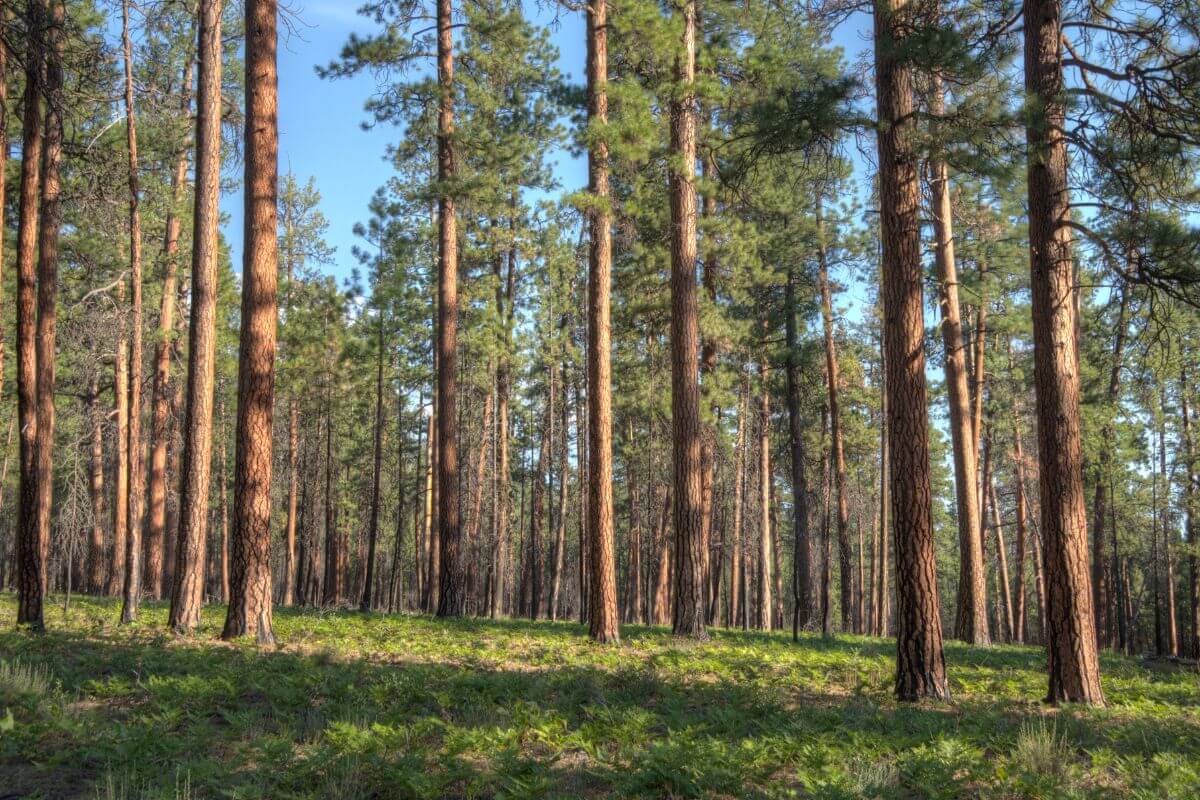
Pine trees are evergreen coniferous trees belonging to the genus Pinus, known for their needle-like leaves and cone production. With over 120 species, most pine trees reach heights of 15-45 meters.
They are primarily found in northern temperate regions, including taiga, coniferous, and mixed forests, and are known for their ability to survive in extreme weather conditions and mountainous regions with steady rainfall and favorable soils.
In Montana, where the climate varies with cold winters and relatively warm summers, pine trees are well-suited for the diverse elevations and topographies. The state’s soil types, including forest soils and mountain soils, provide an optimal environment for pine trees, which thrive in well-drained soils like sandy or loamy soils.
The specific weather and soil conditions in Montana vary by region, with the western part influenced by the Pacific Ocean experiencing milder and wetter conditions compared to the drier eastern regions.
Pine trees in Montana are well-adapted to the state’s climate and soil, making them a common and enduring feature of the landscape.
Types of Pine Trees Located in Montana
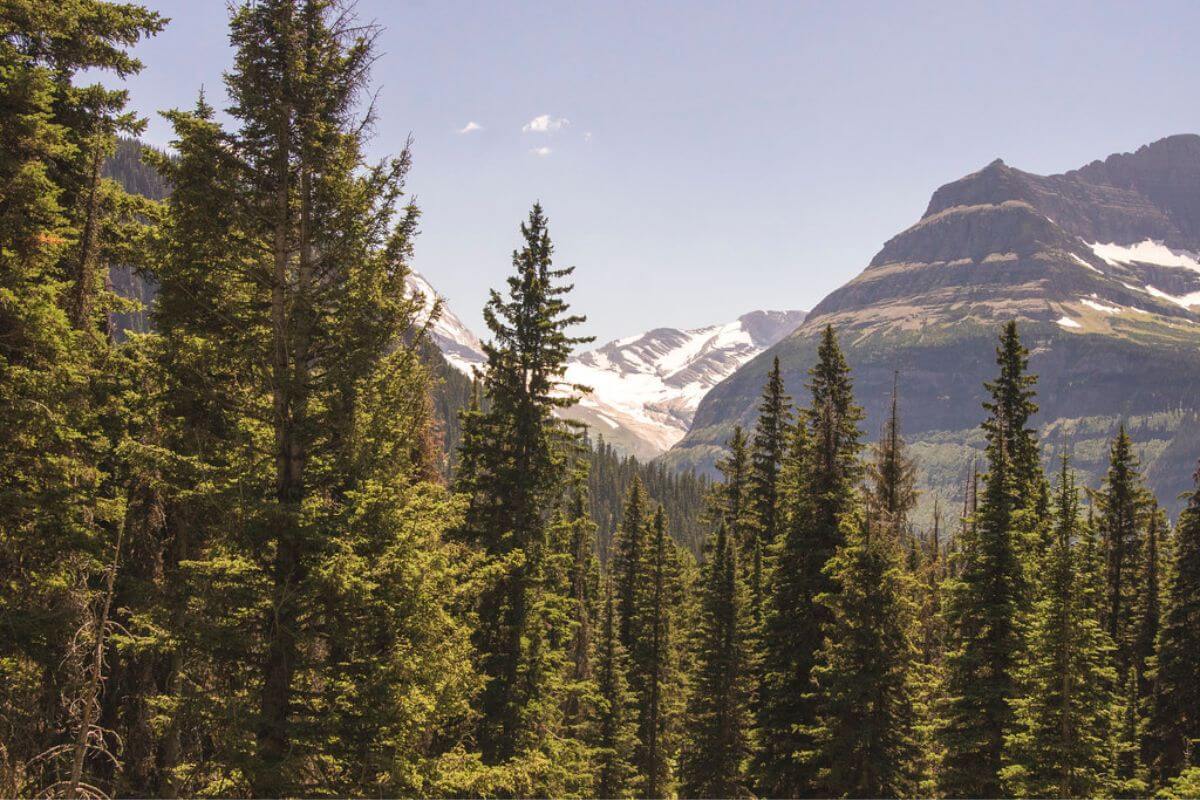
Montana is home to a variety of pine trees, each with its unique characteristics and features.
Montana’s pine trees play a vital role in the ecosystem, offering wildlife habitat, preventing soil erosion, producing oxygen, and serving commercial purposes like lumber, pulpwood, landscaping, and reforestation.
1. Limber Pine (Pinus flexilis)
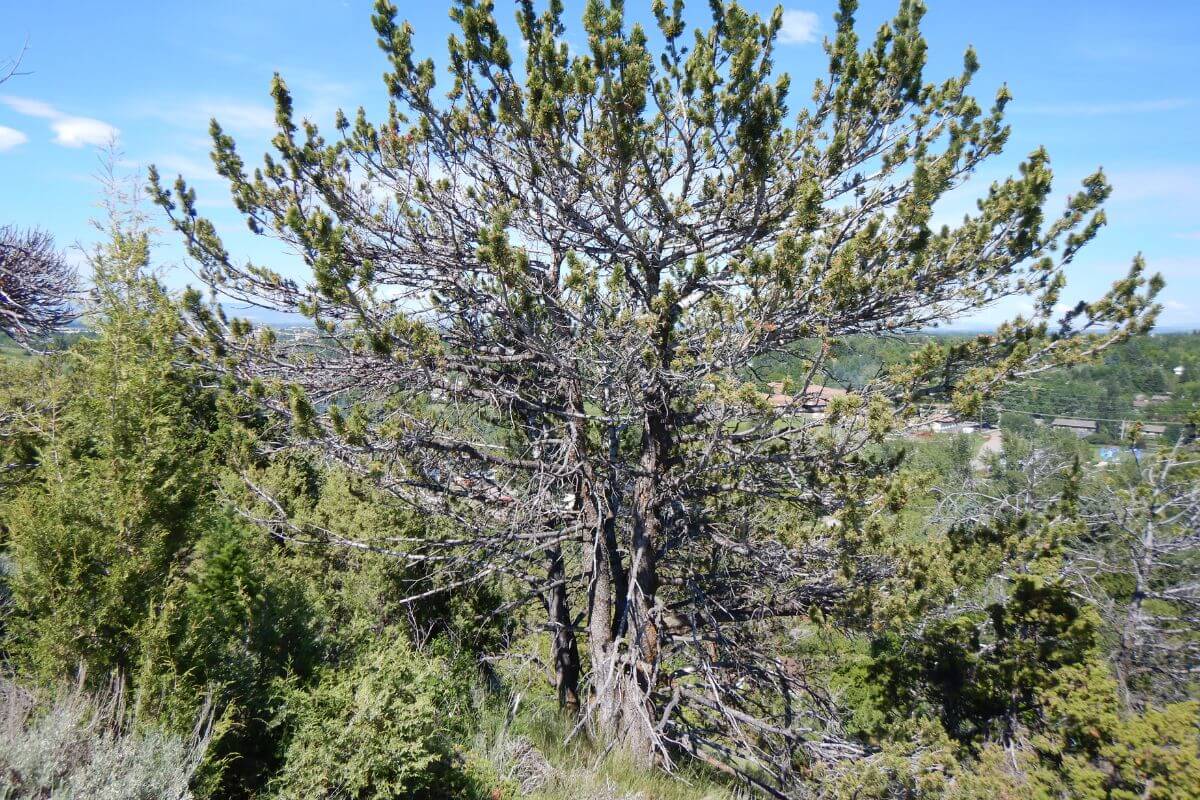
Encountering the Limber Pine in Montana’s Rockies reveals a resilient native, a stalwart in the Rocky Mountain tree community. With a compact pyramidal silhouette, this alpine resident stands out with its lengthy needles, transitioning from dark green to bluish-green, and short-stalked, robustly scaled brown cones.
- Habitat – Thriving at elevations of 5,000 to 12,000 feet, the Limber Pine prefers isolated, open exposures, adopting a charming dwarf shape in Montana’s alpine landscapes.
- Soil and Sun Preferences – Adaptable and hardy, Limber Pines favor well-drained soils and full sunlight, thriving even in the rocky, moisture-scarce soils of high alpine terrains.
- Longevity – Similar to the Yoda of the Rockies, the Limber Pine is slow-growing and long-lived, with verified accounts of some trees exceeding 2,000 years in age.
- Ecological Resilience – Enduring Montana’s unpredictable climate, the Limber Pine serves as a linchpin in maintaining ecological balance, resilient against extreme conditions, and a protector of smaller alpine flora.
In Montana’s alpine tapestry, the Limber Pine stands as a compelling ambassador for resilience, durability, and the remarkable forces of Mother Nature.
2. Ponderosa Pine (Pinus ponderosa)
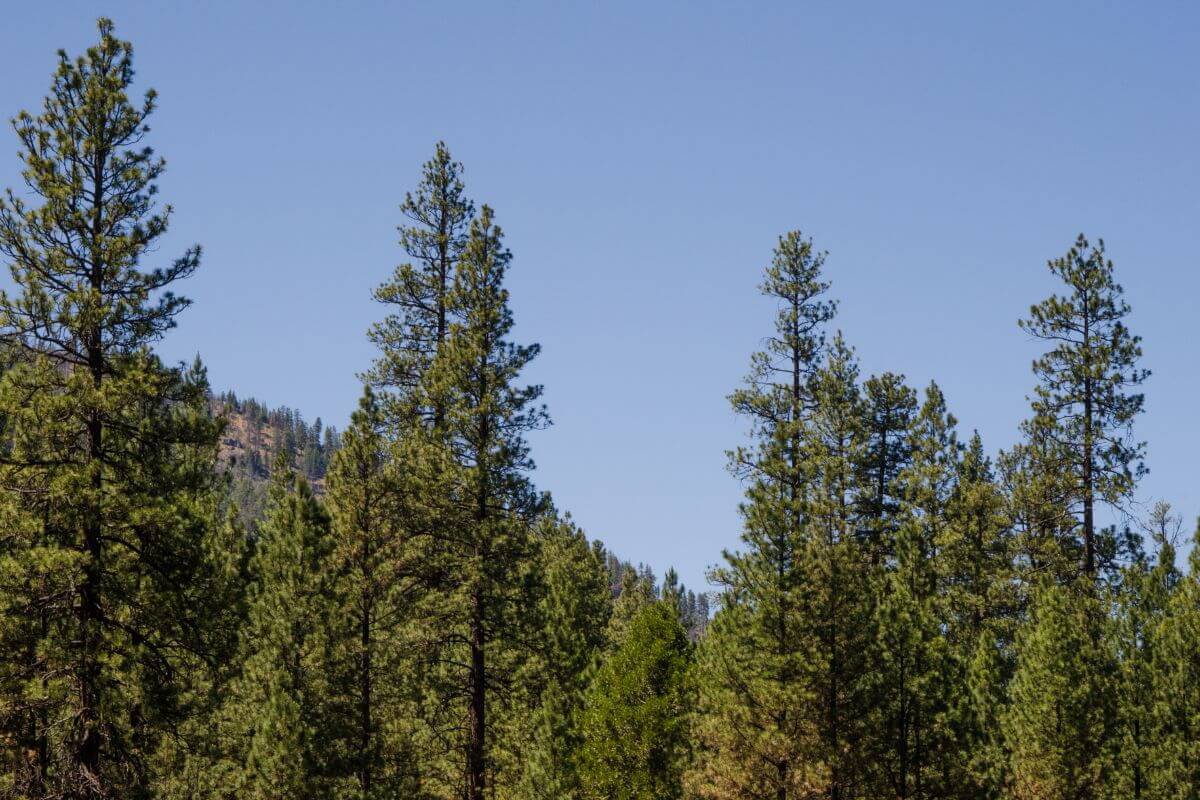
The Ponderosa Pine (Pinus ponderosa) holds the esteemed position of Montana’s state tree, a recognition bestowed in 1949. This iconic species dominates landscapes from central Montana’s dense forests to the arid southeast, playing a vital role in the state’s botanical tapestry.
- Stature by Nature -Reaching heights of up to 65 meters, the Ponderosa Pine boasts an expansive, rounded crown with spreading branches.
- Bark – Older specimens feature thick, furrowed bark that undergoes a captivating color transformation, from brownish-black to a mature yellowish-brown. The unique plate-like structure not only serves as a visual spectacle but also enhances resilience against low-intensity fires.
- Leaves and Light – Thriving in full sunlight, Ponderosa Pines showcase 3 to 5-inch-long needles, often arranged in clusters of 2 or 3.
- Longevity – Under favorable conditions, these trees can endure for centuries, contributing to the enduring vitality of Montana’s forests.
- Preferred Habitats – Typically found in warm, dry forests, Ponderosa Pines coexist with other tree species like Douglas-fir, limber pine, and Rocky Mountain juniper.
- Elevational Diversity – Adaptable across Montana’s varied climates and terrains, Ponderosa Pines flourish from the upper reaches of central Montana to the lower elevations of the southeast.
- Fireproof Characteristics – Earning the title of “guardians of the forest,” Ponderosa Pines exhibit fire-resistant features, including thick bark and widespread roots, making them resilient against low-intensity fires.
The designation of the Ponderosa Pine as Montana’s state tree in 1949 reflects a historical tale of democratic choice by Montana schoolchildren in 1908. Symbolizing the hopes, dreams, and resilience of the Treasure State, this majestic species continues to stand as a formidable guardian of Montana’s forests.
3. Lodgepole Pine (Pinus contorta)
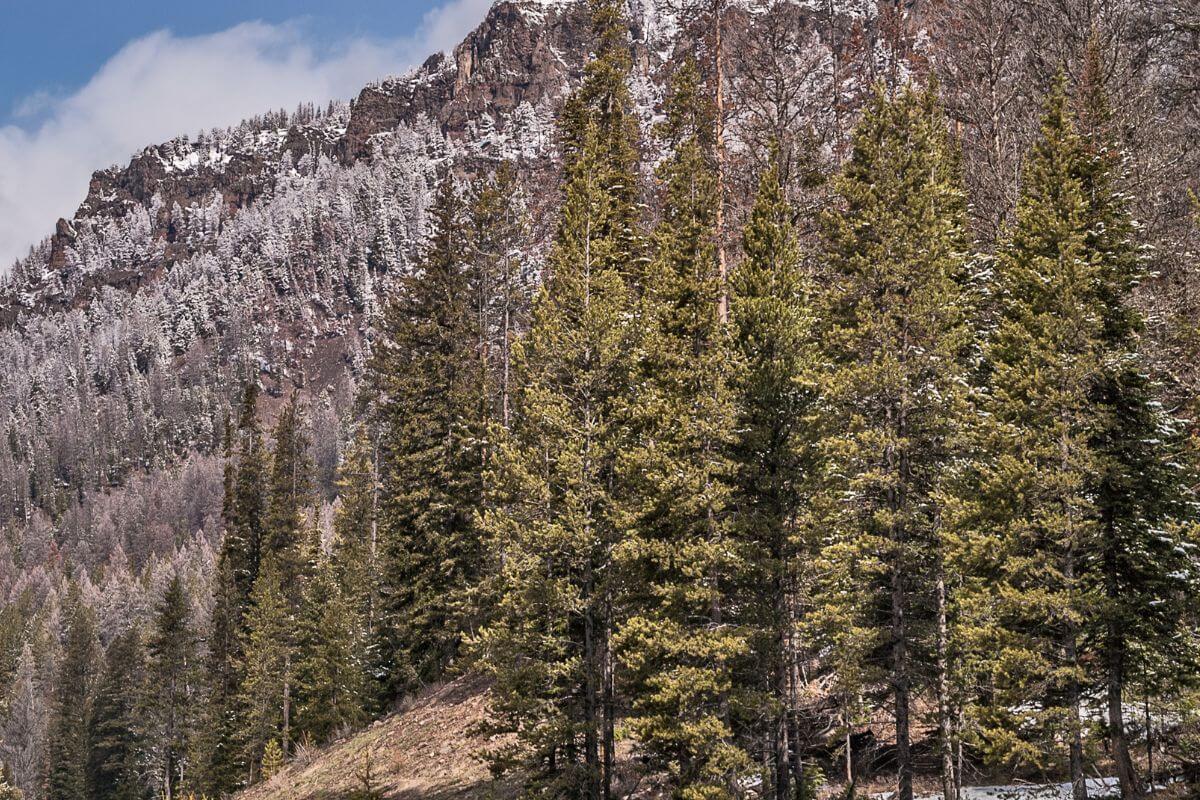
The Lodgepole Pine stands as a slender, small tree, reaching heights of up to 35 meters. Its distinctive conical crown is formed by whorled horizontal branches, while its thin, scaly bark in brown or gray adds to its understated charm.
Known for its aggressive colonization, the Lodgepole Pine exhibits a unique ability to thrive in disturbed soils, making it a formidable presence in the conifer world.
Distributed across diverse habitats in Montana, these pines are commonly found in upper montane to lower subalpine forests along major mountain ranges. Requiring full sunlight, they grace slopes of varying degrees and aspects, from volcanic rock to valley bottoms.
Thriving across a broad elevation range, Lodgepole Pines can be found from as low as 975 meters to an impressive 2,743 meters. Their adaptability is showcased in Montana’s Rocky landscapes and the Bighorn and Beartooth ranges of south-central Montana.
Beyond their aesthetic appeal, Lodgepole Pines play a crucial role in forest ecosystems. As a seral species, they often follow Douglas-fir forests in specific Montana areas, contributing to the delicate dance of forest renewal.
While Montana proudly hosts Lodgepole Pines, these resilient trees also grace regions beyond, including the western side of the Cascades, the Rocky Mountains in Alberta, and southern Colorado.
It’s essential to note that the information provided pertains specifically to the Lodgepole Pine species found in Montana. Unique traits and distribution patterns may not be universally applicable to all varieties of Pinus contorta.
4. Rocky Mountain Juniper (Juniperus scopulorum)
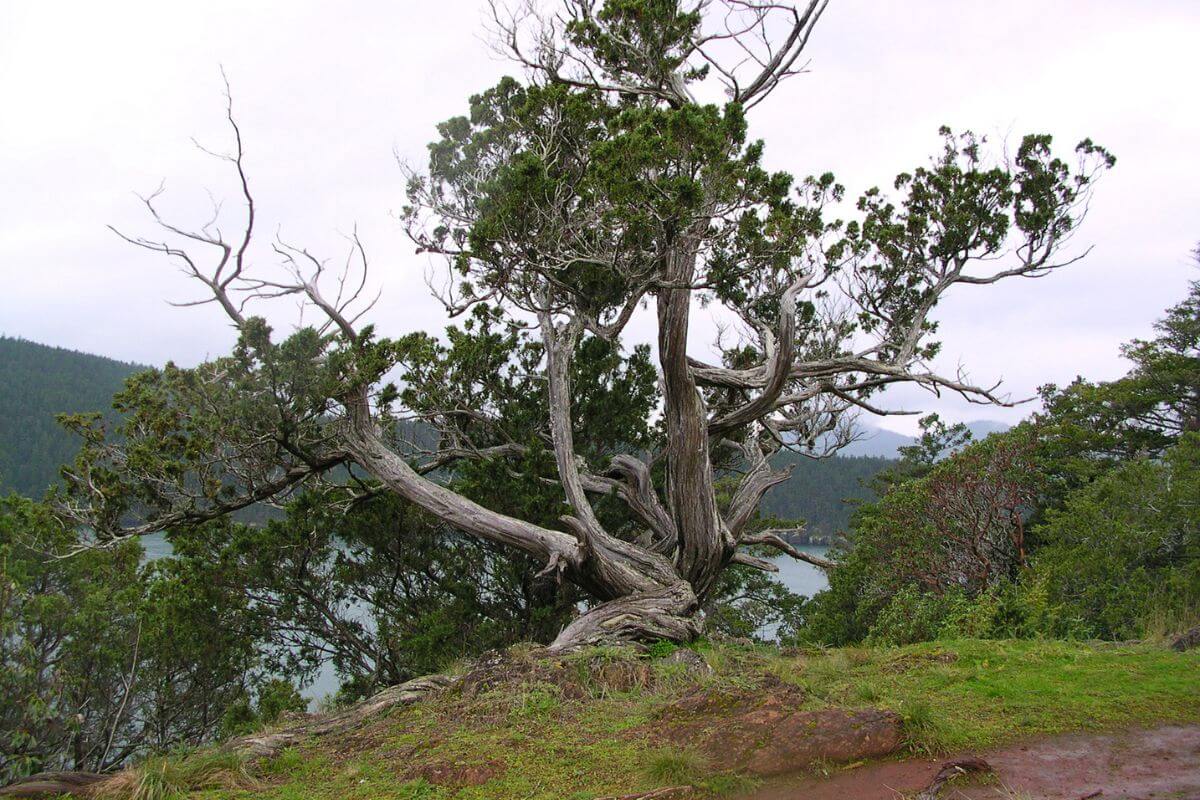
The Rocky Mountain Juniper (Juniperus scopulorum) stands as a resilient emblem of longevity, enduring up to an astonishing 300 years when nurtured in suitable conditions.
Originating from the expansive and picturesque landscapes of western North America, including the state of Montana, this majestic tree spans its leafy arms from southwest Canada to the Great Plains of the United States. Esteemed for its adaptability, it has earned favor among landscapers seeking a plant that withstands the test of time.
Key Features of the Rocky Mountain Juniper:
- Height and Spread – Reaching a height of 30-40 feet and boasting a spread of 3-15 feet, the Rocky Mountain Juniper commands attention with its stature and presence.
- Maintenance – A paragon of low maintenance, this tree is of the unobtrusive kind, demanding minimal attention while flourishing in its environment.
- Soil and pH Tolerance – Exhibiting remarkable versatility, it thrives in various soil types, including chalk, clay, loam, and sand. Its adaptability extends to pH levels, with contentment in acidic, alkaline, and neutral conditions.
- Habitat – Flourishing in open-tree canopies, the Rocky Mountain Juniper finds its niche in the patchy woodlands of Montana, often cohabitating harmoniously with fellow natives such as the limber pine (Pinus flexilis).
- Root System – Typically featuring a shallow-rooted structure, this tree frowns upon heavy grazing and erodible soils in exposed sites.
- Disease Resistance – Demonstrating stoic resilience, the Rocky Mountain Juniper is not impervious to threats. Vigilance is required to monitor for potential issues, particularly with cedar flathead borers and mistletoes.
In Montana, it is not uncommon to witness the Rocky Mountain Juniper thriving in synergy with other native species, exemplified by its companionship with the limber pine.
While this tree exhibits a robust capacity for survival in diverse environments, it is not impervious to challenges. Regular checks become imperative to safeguard against potential disruptions caused by mistletoes and cedar flathead borers.
5. Engelmann Spruce (Picea engelmannii)
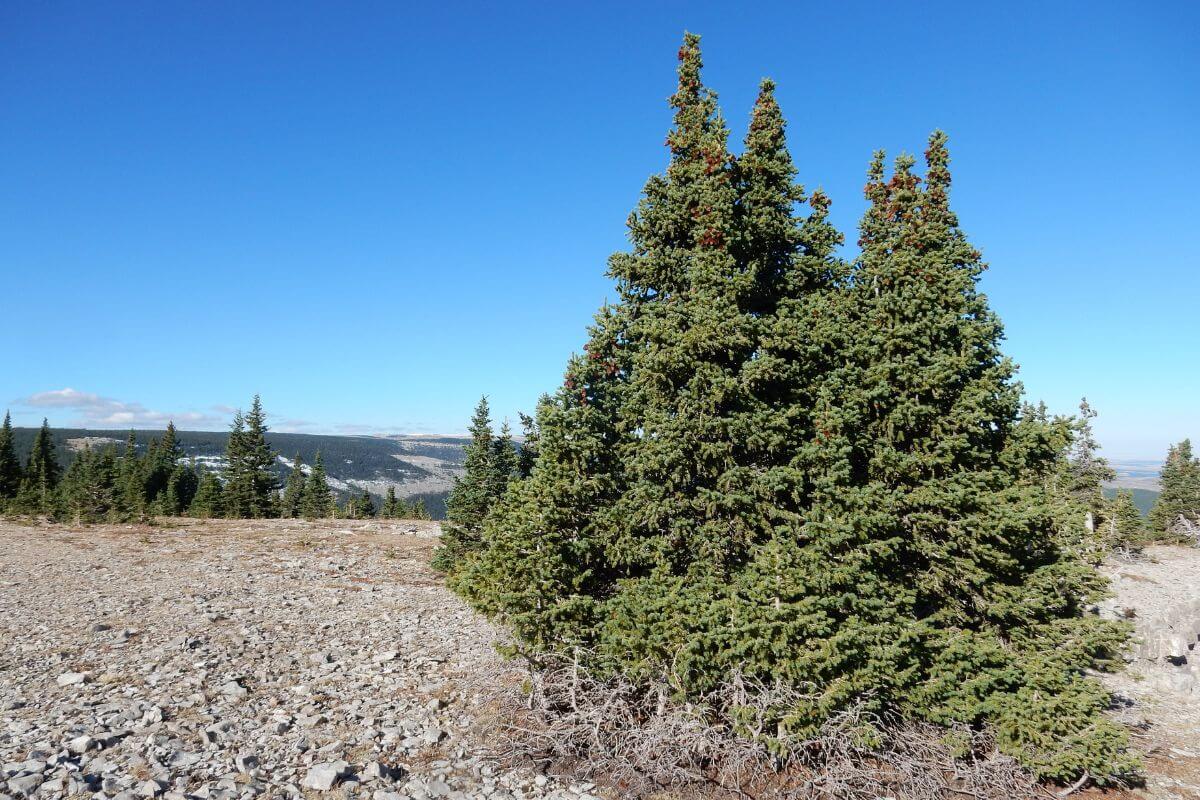
The Engelmann Spruce (Picea engelmannii) stands as a commanding presence in the forests of Montana, contributing a significant natural music note to the symphony of the state’s environmental landscape. This medium to large evergreen reaches impressive heights, often ascending to 65 meters, nearly rivaling the Leaning Tower of Pisa in stature.
Its distinctive slim, conical crown and bark resembling a well-worn leather jacket, characterized by thin, scaly, reddish skin that sheds in circular patterns, make it easily recognizable.
The shoots of the Engelmann Spruce exhibit a warm buff-brown to orange-brown hue, providing a visual treat reminiscent of a rich cup of cocoa.
The leaves, in a shade of blue-green, are densely packed and measure approximately 1-2 centimeters in length, akin to tiny soldiers standing in formation. Thriving in Montana’s high-altitude regions, particularly in the Purcell and Bitterroot Mountains, this tree displays a preference for locations with thin air.
Under optimal conditions, these arboreal giants can soar past 160 feet in height, exemplifying their Goldilocks-like adaptability to Montana’s cold winters and their affinity for moisture-rich soil during the growing season.
However, despite their robust appearance, Engelmann Spruce is not invulnerable. The species can succumb to threats such as bark beetles and low-intensity fires.
The tree’s resilience manifests as a ‘choose your own adventure’ narrative, where regrowth becomes a possibility, allowing it to start anew after encountering challenges in its lifecycle. Thus, the Engelmann Spruce, with its grandeur and unique characteristics, adds both stature and intrigue to the diverse ecosystems of Montana.
6. Douglas Fir (Pseudotsuga menziesii)
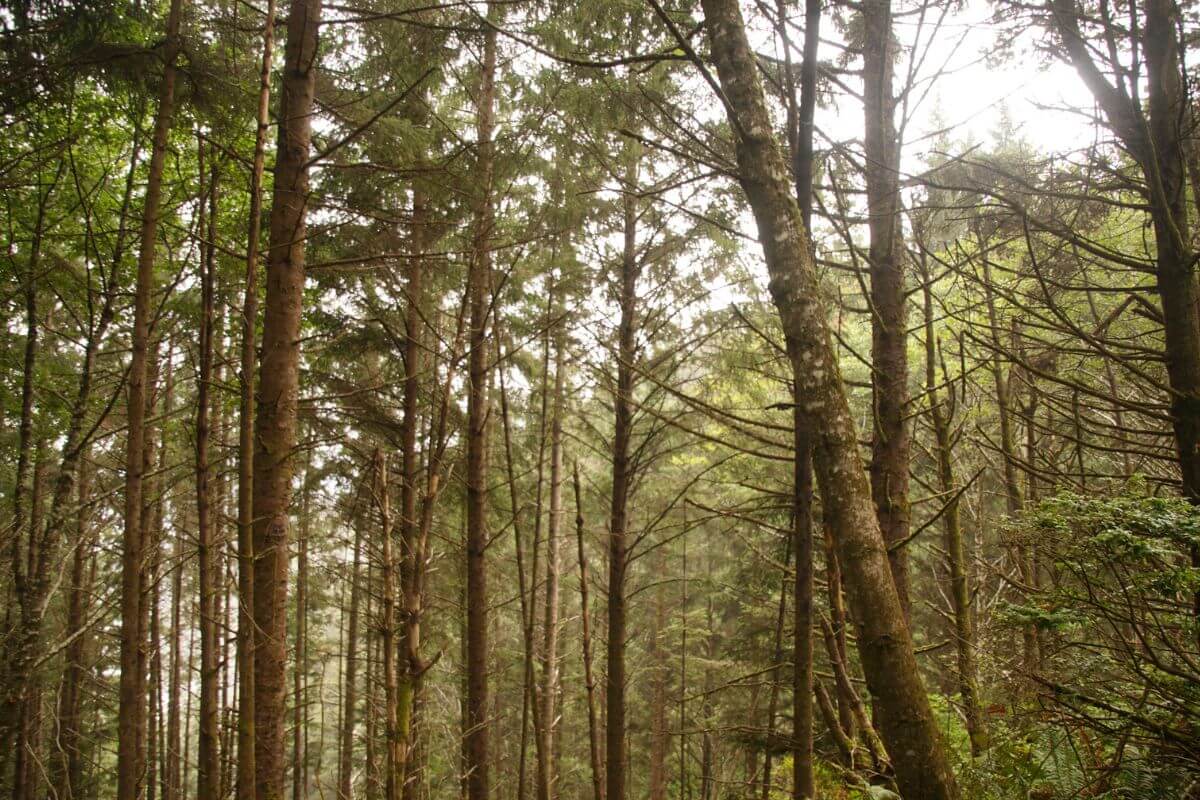
The Douglas Fir, scientifically known as Pseudotsuga menziesii, stands as a formidable figure in Montana’s diverse landscape, contributing significantly to the state’s arboreal tapestry.
Its imposing size, reaching heights of up to 60 meters, designates it as a remarkable presence in the forest canopy, marked by a conical crown and expansive branches that create a distinctive silhouette.
The bark of the Douglas Fir adds to its venerable demeanor, characterized by thickness, corkiness, and furrows with ridges, resembling the weathered exterior of a wise old soul. The needles of the Douglas Fir, measuring 2-4 centimeters in length, emit an invitingly sweet fragrance when crushed, reminiscent of a piney potpourri.
Notably, its cones, ranging from 6 to 10 centimeters in length, bear a distinct “mouse tail,” a feature that aids in easy identification. Thriving in diverse habitats, from coastal regions to mountainous peaks, the Douglas Fir showcases its versatility within Montana’s mixed forests.
In terms of growth, this resilient conifer mirrors the wisdom of an elder, experiencing rapid vertical ascent in its youth before gradually slowing down as it matures.
Beyond its natural magnificence, the Douglas Fir plays a pivotal role in Montana’s timber industry, earning the moniker of “timber gold.” It is also a cherished choice for Christmas trees and decorative wreaths, reflecting its cultural significance.
Despite its impressive stature, the Douglas Fir is not impervious to threats. Susceptibility to bark beetles, various insects, and certain diseases underscores the challenges it faces.
However, the species displays resilience, capable of rebounding after damage caused by low-intensity fires. In essence, the Douglas Fir encapsulates both the grandeur of nature and its intricate role in shaping Montana’s ecosystems and industries.
7. Subalpine Fir (Abies lasiocarpa)
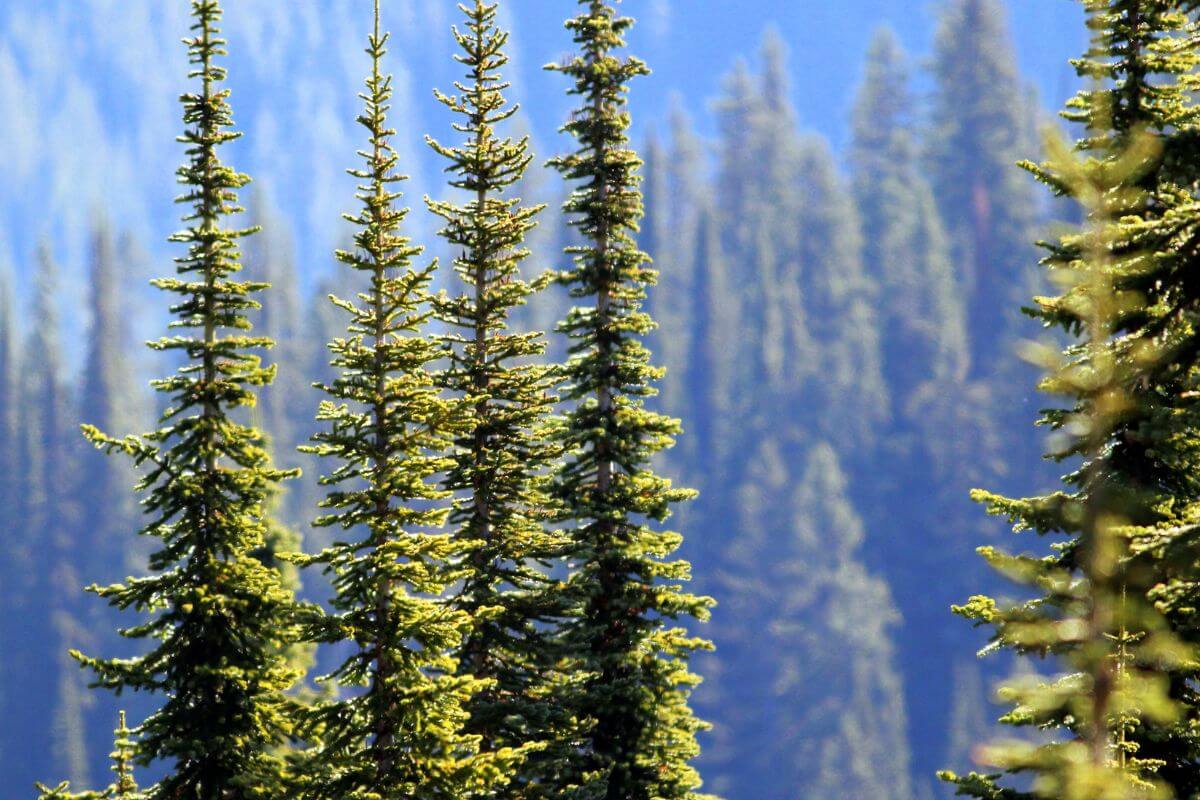
The Subalpine Fir, scientifically identified as Abies lasiocarpa, emerges as a distinctive and elegant presence within the Rocky Mountains, earning the fitting epithet of the “Queen of the Rockies.” Characterized by its slender and spire-like silhouette, this coniferous beauty stands tall in the cool, moist, high elevations of western North America, including the state of Montana.
- Description – The Subalpine Fir exhibits a gracefully tall stature with a narrow, spire-like crown, complemented by smooth and silvery-gray bark. The striking blue-green needles of this species curve upward, revealing shimmering blue-white bands underneath, enhancing its visual allure.
- Habitat – Thriving in the cool, moist environs of high elevations, the Subalpine Fir is a native inhabitant of the Rocky Mountains, contributing to the region’s enchanting landscape. Flourishing in poor, rocky soils, this fir often coexists with the Engelmann Spruce in the Rockies, illustrating its adaptability to challenging environmental conditions.
- Growth Preferences – The Subalpine Fir finds its hardy home in USDA zones 5-6, showcasing its resilience in diverse climates. Demonstrating shade tolerance, this species strategically capitalizes on sunlit opportunities, exhibiting rapid growth when conditions are favorable.
Recognized for its unique aesthetic, the Subalpine Fir is in demand as a Christmas tree and holds a cherished place in expansive gardens as an ornamental feature. Beyond its visual appeal, the wood of the Subalpine Fir serves practical purposes, finding utility in countless homes as lumber.
Its pulping properties also make it a favored choice in paper production, underscoring its versatile contributions beyond its natural habitat.
8. Pacific Yew (Taxus brevifolia)
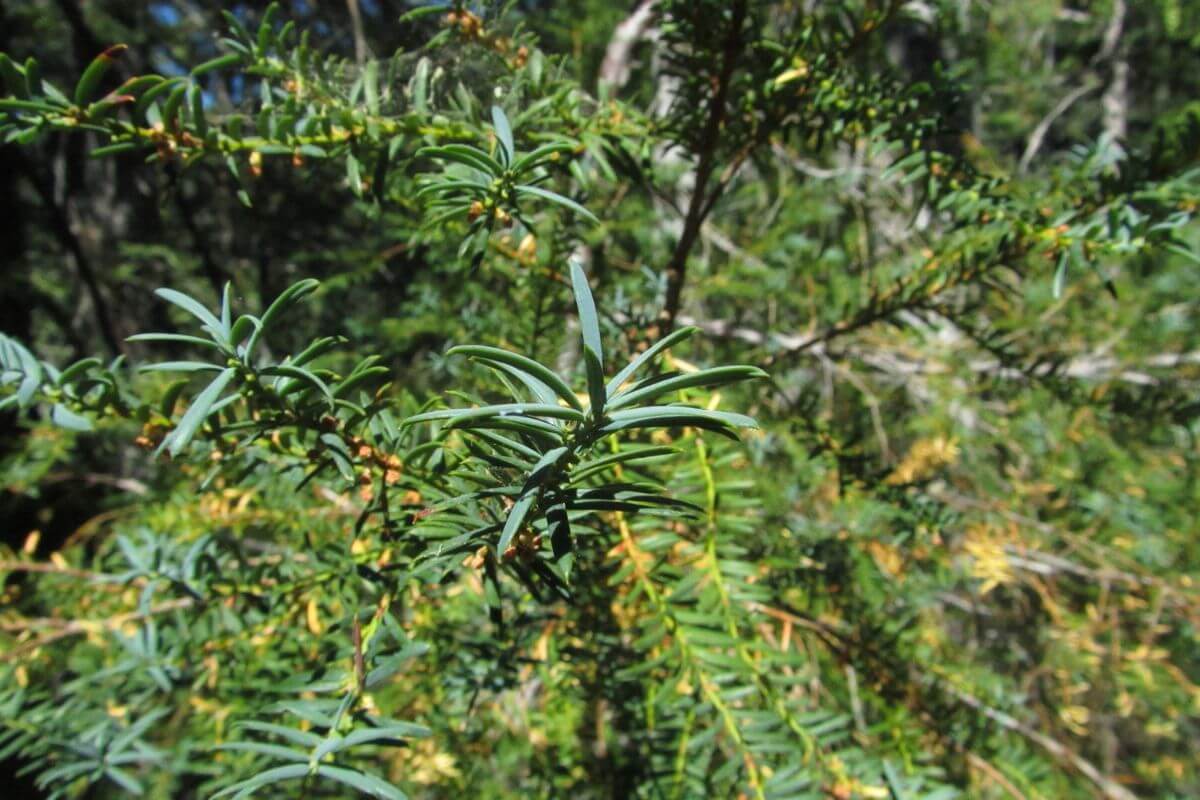
The Pacific Yew, scientifically known as Taxus brevifolia, is a modest yet consequential conifer, boasting distinctive characteristics and deep-rooted significance.
- Description – The Pacific Yew is a small to medium-sized evergreen with spiral needles measuring 1-3 cm long. Reaching heights of 30-50 feet, its bark is papery thin, and scale-like, presenting in brown to purplish hues. Botanists identify this species by its unique 4-7mm long seed cones that mature into arils, providing a distinctive feature for identification.
- Habitat – Native to the moist and shady regions spanning western North America, from British Columbia to California, the Pacific Yew thrives amidst the layered greenery of dense forests.
- Growth and Longevity – Characterized as a slow grower, the Pacific Yew takes its time, reaching a mature age of 250-350 years. Many specimens surpass this, enduring for several centuries, and contributing to the rich tapestry of nature.
- Usage and Medical Importance – Beyond its unassuming appearance, the Pacific Yew holds value beyond the lumber mill. Its non-resinous wood, renowned for its hardness and strength, is sought after for various items, including furniture and musical instruments. However, the true star quality lies in Taxol, a vital cancer medicine derived from the tree’s bark.
- Wildlife Relations – The ecological interplay extends to wildlife, with birds partaking in the act. Birds feast on the fleshy arils of the Pacific Yew, contributing to seed dispersal as they deposit the seeds through their droppings.
The Pacific Yew, with its dual role as a utilitarian resource and a source of medical significance, weaves a compelling narrative. Whether contemplating a bench made of Pacific Yew for a porch or appreciating the invaluable contribution of Taxol to medical science, this unassuming conifer reveals its multifaceted impact on both human lives and ecosystems.
9. Western Hemlock (Tsuga heterophylla)
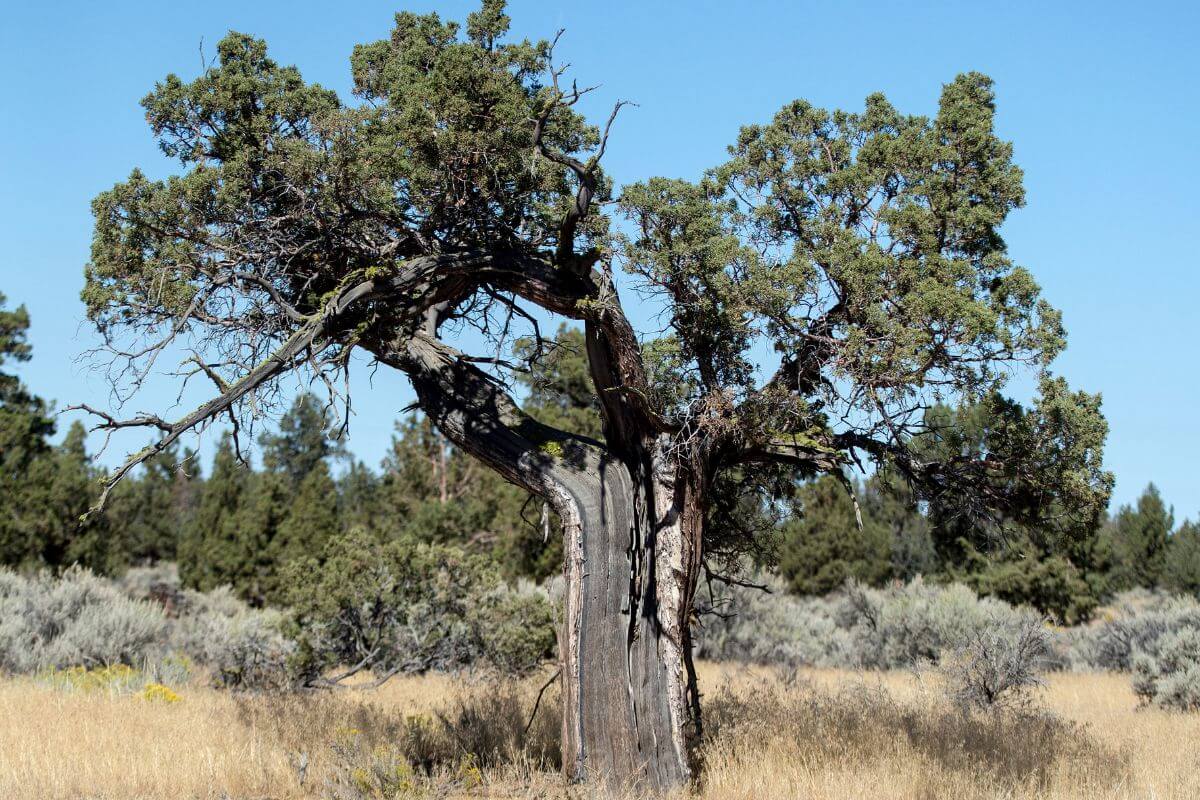
The Western Hemlock (Tsuga heterophylla) commands attention in Montana’s pine forests, standing impressively tall at heights ranging from 125 to 175 feet. The crown of this majestic tree forms a pyramidal shape, characterized by a dense and drooping structure, with a leader that gracefully droops at the apex.
The bark of the Western Hemlock evolves intriguingly throughout its life, transitioning from smooth and gray-brown with resin blisters in youth to a mature state of deeply grooved, cork-like, and gray-brown.
The needles, distinctively measuring 1/4-3/4 inch in length, possess rounded ends and showcase a dark shiny green on the upper surface, contributing to the tree’s unique character within Montana’s pine forests.
The Western Hemlock (Tsuga heterophylla) adorns itself with hanging cones, measuring 3/4-1 inch, oblong, and light brown. Native to the Pacific coast and northern Rocky Mountains, it thrives in southeastern British Columbia, northern Idaho, and southwestern Montana. Flourishing in deep, moist soils of humid areas and mid-mountain forests, it adds a distinctive presence to regional ecosystems.
Beyond its aesthetic appeal, the Western Hemlock holds notable significance. Serving as the state tree of Washington, it also stands as an economically important species. Its imposing presence contributes to the visual allure of national parks.
Despite its grandeur, the Western Hemlock faces challenges, notably with its shallow root system making it susceptible to wind damage and its intolerance to drought. However, its ecological importance in Montana’s landscapes cannot be overstated.
It provides crucial browse for deer and elk, and its towering stature contributes to the shading and grandeur of the state’s diverse ecosystems. The Western Hemlock, with its towering height and distinctive features, stands as a testament to the remarkable biodiversity of Montana’s pine forests.
10. Western Larch (Larix occidentalis)
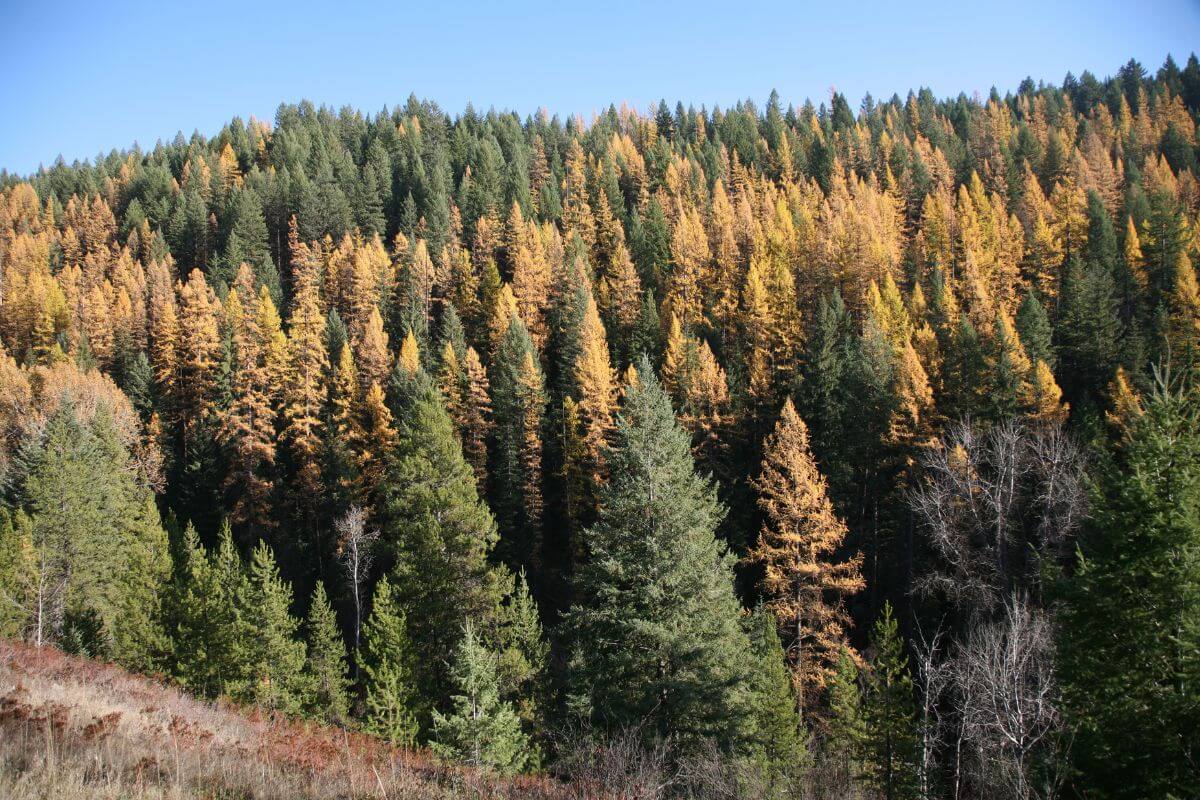
The Western Larch (Larix occidentalis) is a large tree that can grow up to 150 feet tall and live over 700 years. Its soft needles are 1-2 inches long and grow in clusters of 15-30 on dwarf twigs. This deciduous tree loses its needles every autumn and regrows them in the spring. Its cones are about 1 ½ inches long and brown to reddish.
The Western Larch is found in moist to wet forests, thriving in cool slopes and valleys to lower subalpine terrain. It depends on growing alongside other tree species, such as Douglas-fir and Lodgepole Pine, and is a long-lived seral species that grows on all exposures. It is a shade-intolerant pioneer species well-adapted to nutrient-poor soils and burned sites.
This tree is an important timber species used for lumber, fine veneer, poles, ties, mine timbers, and other wood products due to the strength of its wood. It is also significant for wildlife, providing habitat for elk, deer, bear, blue and spruce grouse (which eat the needles), and crossbills (which eat the seeds).
The Western Larch is valuable for its wood, its ability to provide habitat for wildlife, and its longevity as a tree species.
11. Whitebark Pine (Pinus albicaulis)
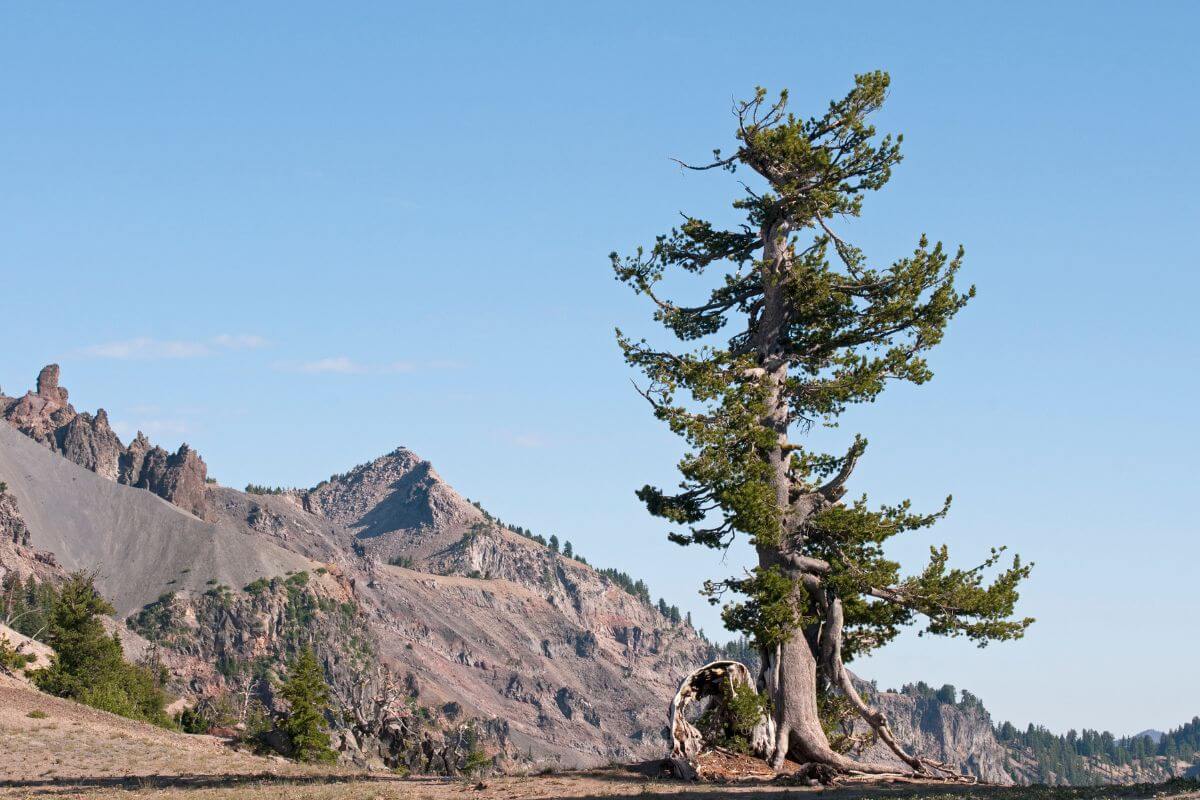
The Whitebark Pine (Pinus albicaulis), a slow-growing and remarkably long-lived species, epitomizes endurance with some trees standing for well over a millennium.
- Growth Characteristics – The Whitebark Pine (Pinus albicaulis) is a poster child for slow and steady growth, showcasing enduring qualities that have allowed some of these pines to stand for well over a millennium.
- Native Habitat – Most commonly found in subalpine and timberline zones, the Whitebark Pine thrives in high-altitude environments characterized by extreme cold, embodying resilience in challenging climates.
- In Montana – Montana stands as the preferred vacation spot for Whitebark Pines, covering about 5 million acres or roughly a fifth of the national forest lands in the state, akin to a tree equivalent of a Yellowstone getaway.
- Conservation Concern – Despite its robust characteristics, the Whitebark Pine faces conservation challenges, leading to active restoration efforts to ensure its continued presence and ecological contributions.
- Ecological Importance – Beyond its resilience, the Whitebark Pine is a keystone species that orchestrates entire ecosystems, highlighting its significant role in maintaining ecological balance.
- Seed Production – The seeds produced by Whitebark Pines aren’t just botanical processes; they are highly nutritious and sought after by birds and various furry creatures, contributing to biodiversity.
- Supporting Watershed Integrity – The Whitebark Pine goes beyond being a pretty sight, playing a vital role in maintaining watershed health. This, in turn, supports activities like fishing and preserves the habitats of Montana’s famous wildlife.
In essence, the Whitebark Pine stands as a symbol of resilience and ecological importance, with its enduring presence in Montana’s landscape emphasizing the need for conservation efforts to protect its centuries-old wisdom and contributions to the environment.
12. Mountain Hemlock (Tsuga mertensiana)
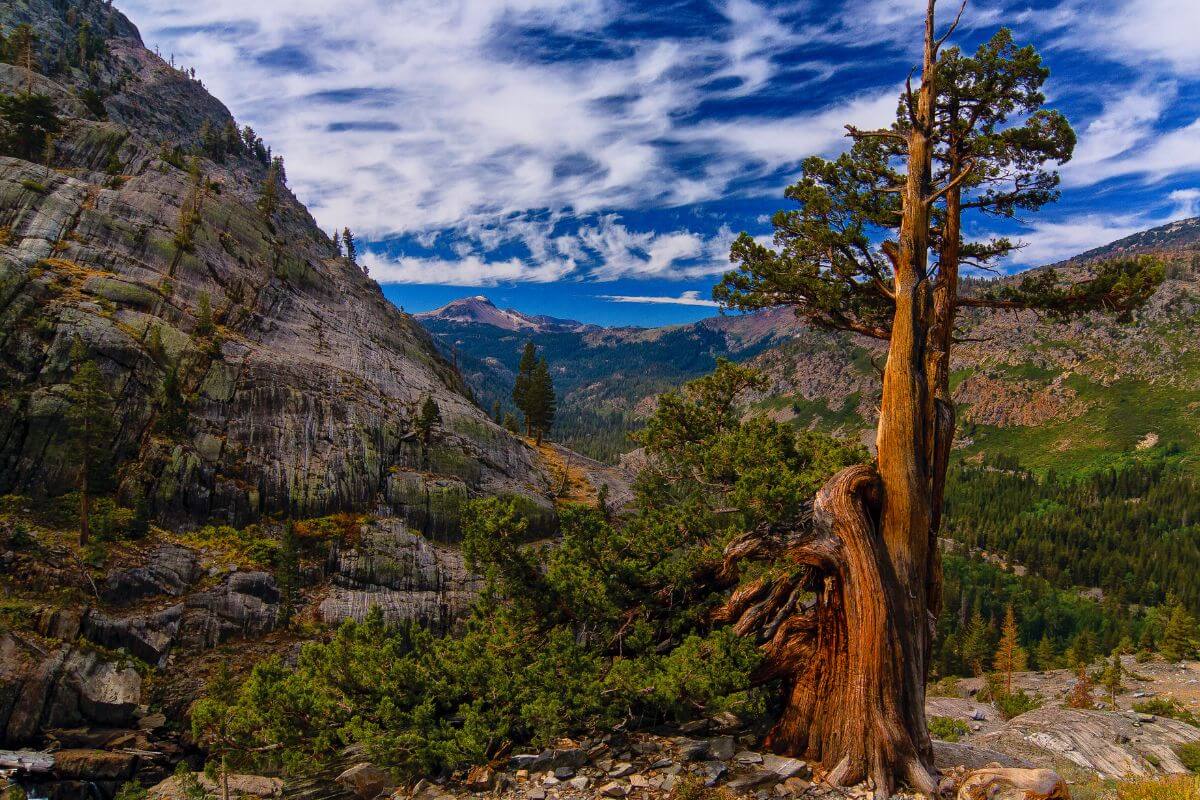
The Mountain Hemlock, scientifically known as Tsuga mertensiana, is a towering figure within Montana’s diverse coniferous landscape. Here’s a deeper look at what makes this tree stand out:
- Size – The stately Mountain Hemlock can reach impressive heights of up to 40 meters, but the elevation and soil conditions in certain areas often stunt its growth. One distinctive feature is its drooping leader, which isn’t as pronounced as in the Western Hemlock.
- Bark and Needle Arrangement – Recognizable by its thick, furrowed bark that takes on a purplish to reddish-brown hue, the Mountain Hemlock’s needle arrangement is unique. Needles grow in a circular arrangement around each branch, creating a visually appealing cross-section.
- Habitat and Growth Characteristics – This slow-growing tree thrives on cold, snowy subalpine sites, particularly in isolated populations in north-facing glens and cirque basins. It’s an expert at weathering heavy snowpacks, with bent boles and branches that spring erect post-snowmelt.
- Uses and Cultivation – While Native Americans didn’t employ Mountain Hemlock as extensively as Western Hemlock, they valued its boughs for beds and bathing brushes. Since the mid-20th century, it has gained traction in the lumber industry, often mixed with Western Hemlock. Beyond its native range, the Mountain Hemlock is also cherished as an ornamental tree.
- Significance for Wildlife – The Mountain Hemlock plays a vital role in supporting local wildlife. Its boughs provide shelter and nesting sites for various bird species, while the tree’s needles and cones are important food sources for animals like small mammals and bears.
The interplay between the Mountain Hemlock’s unique growth habits, ecological importance, and cultural significance makes it a fascinating subject for nature enthusiasts and conservationists alike.
13. Western White Pine (Pinus monticola)

The Western White Pine (Pinus monticola) is a large tree that can grow up to 200 feet tall, with a straight trunk and a narrow, conical crown. Its bark is smooth and grayish-brown when young, becoming thick and deeply furrowed on older trees.
The needles of the Western White Pine are 2-4 inches long, bluish-green, and grow in bundles of five. Its cones are 6-12 inches long, with a distinctive shape, a long, curved stem, and broad, flat scales.
It is found in a variety of habitats, from low to high elevations, and is commonly found in mixed conifer forests in Montana. The Western White Pine is a long-lived tree that can live for hundreds of years, with fast growth in the early years, slowing down as the tree matures.
It is an important timber tree, used for lumber, plywood, and other wood products, as well as for Christmas trees and for making wreaths and decorations from its needles and twigs.
However, the species is vulnerable to bark beetles, other insects, and diseases such as white pine blister rust, and is susceptible to fire damage. Despite this vulnerability, the Western White Pine is capable of recovering quickly from low-intensity fires.
Montana Pine Trees Final Thoughts
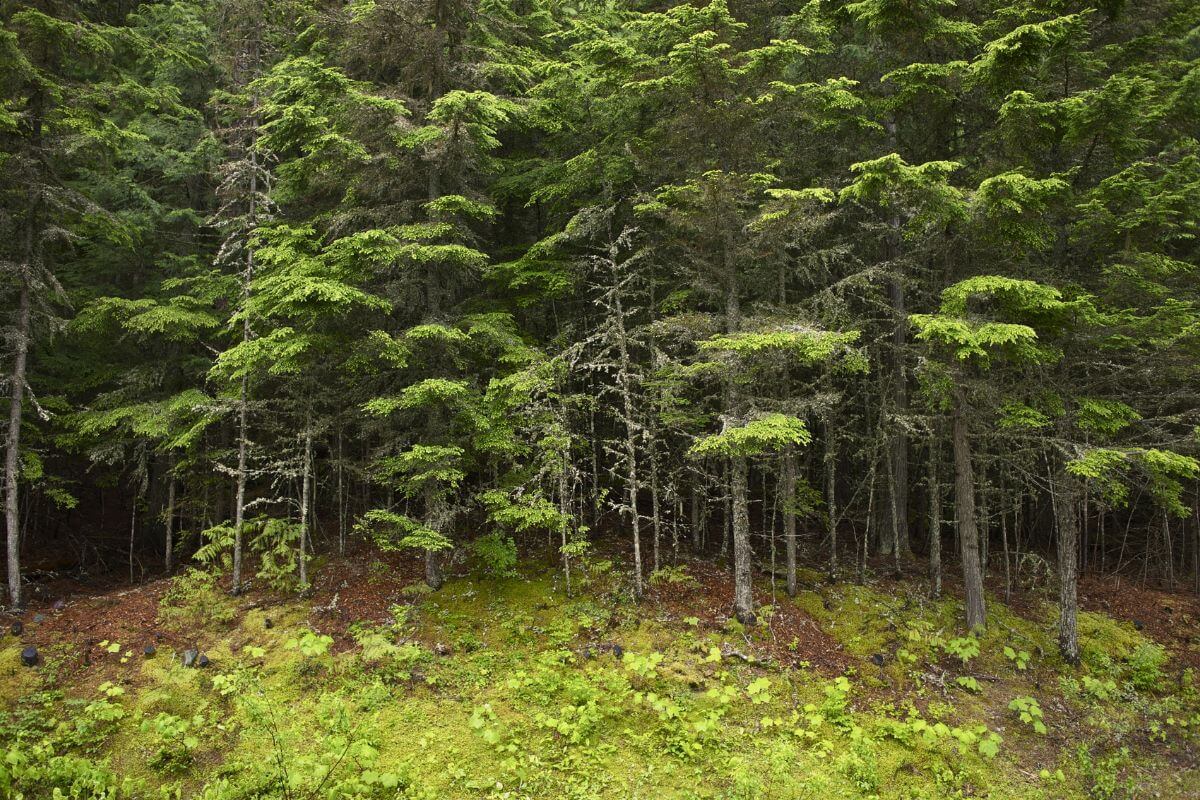
Montana’s diverse ecosystems owe much to the pivotal role played by evergreen giants such as the Western White Pine and Limber Pine.
These towering pines have unique adaptations to Montana’s varied climates and elevations, shaping the state’s landscapes. The iconic Ponderosa Pine, Montana’s state tree, thrives in warm and dry forests and contributes significantly to the state’s ecological balance.
The at-risk Whitebark Pine symbolizes resilience, crucial for supporting wildlife and stabilizing soils in Montana. The state’s diverse pine species mirror climatic and topographic variations, ranging from the western influence of the Pacific Ocean to the arid expanses in the east.
Notable species, such as the fire-resistant Lodgepole Pine and slow-growing Engelmann Spruce, play integral roles in the complex tapestry of Montana’s pine-dominated landscapes.
Pine trees play a crucial role in providing habitat for wildlife and protecting watersheds. Their adaptability and persistence in Montana’s ever-changing environments underscore their ecological significance. They maintain a delicate balance in sustaining diverse ecosystems and are a defining feature of the state’s natural beauty and resilience.
Montana Pine Trees FAQs
1. What Trees Are Most Common in Montana?
In Montana, the most common trees include the Ponderosa Pine (Pinus ponderosa), Lodgepole Pine (Pinus contorta), Douglas Fir (Pseudotsuga menziesii), Western Larch (Larix occidentalis), and Engelmann Spruce (Picea engelmannii).
These species thrive across Montana’s diverse landscapes, contributing significantly to the state’s unique ecosystems. The prevalence of these trees reflects their adaptability to Montana’s varying climates and elevations.
2. What Is Montana State Tree?
The state tree of Montana is the Ponderosa Pine (Pinus ponderosa).
Recognized for its towering stature and adaptability to Montana’s warm and dry forests, the Ponderosa Pine was officially designated as the state tree in 1949. Its prominence in the state underscores its ecological and cultural significance.
3. Does Montana Have Spruce Trees?
Yes, Montana is home to several species of spruce trees, including the Engelmann Spruce (Picea engelmannii) and the Subalpine Fir (Abies lasiocarpa), which is sometimes referred to as a spruce.
4. What Trees Grow Best in Montana?
Trees that grow best in Montana are those well-adapted to the state’s diverse climates and elevations.
Species such as the Ponderosa Pine, Lodgepole Pine, Douglas Fir, and Western Larch thrive in Montana’s warm and dry forests, while high-elevation trees like the Subalpine Fir and Engelmann Spruce flourish in the cooler mountainous regions, contributing to the state’s rich and varied ecosystems.
Loved this read? Dive deeper into Montana’s wonders with more captivating articles in our dedicated section:
- https://fieldguide.mt.gov/displaySpecies.aspx?family=Pinaceae
- https://fieldguide.mt.gov/speciesDetail.aspx?elcode=PGPIN040M0
- https://www.fs.usda.gov/detail/hlcnf/landmanagement/resourcemanagement/?cid=stelprdb5378437
- https://www.flickr.com/photos/toomanytuxedos/23468219478/
- https://www.flickr.com/photos/plant_diversity/48155365671/
- https://www.flickr.com/photos/brewbooks/373237569/
- https://www.flickr.com/photos/plant_diversity/37178954300
- https://www.flickr.com/photos/56775593@N05/5347003181/
- https://commons.wikimedia.org/wiki/File:Western_white_pine_-Flickr-_brewbooks.jpg

